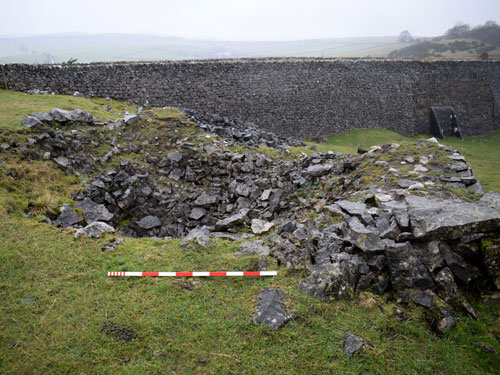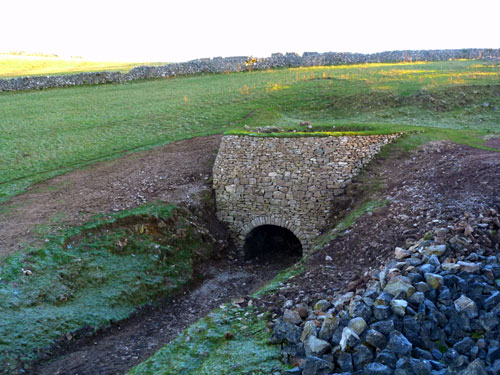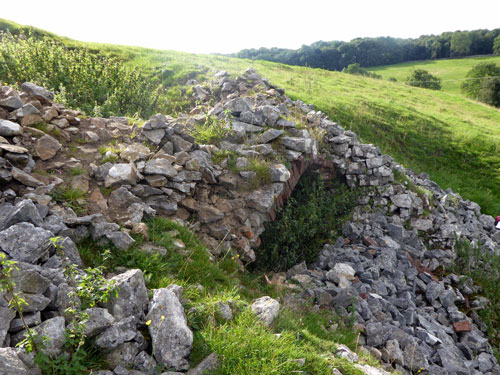Protecting our cultural heritage: Limekilns

Farming in Protected Landscapes (FiPL) is enabling us to give grants to farmers and land managers to aid heritage conservation, to protect and enhance cultural heritage in the National Park.
Limekilns are a visible link to our agricultural and industrial past. It is important to preserve these structures in place to reveal our landscape stories.
Read on to find out about three limekilns we've been able to protect with FiPL support.
Rescuing Minninglow limekiln

Visitors to the High Peak Trail will be familiar with the impressive limestone embankment that curves gracefully around the western flank of Minninglow Hill. Formerly the Cromford and High Peak Railway, this section is testament to the early 19th century railway builders. Such is its significance, part of the embankment is a listed building. Perhaps less well-known are the heritage features that relate to the railway’s construction.
Next to the trail, a disused limestone quarry once provided raw material for the embankment, now it’s a valuable wildlife habitat. Nearby, a large limekiln built in limestone blocks stands five metres high, set into a cutting in the hill. A smaller quarry next to it would have had stone extracted, broken up and fed into the top of the kiln, to be burnt and raked out from the arch below. We believe the lime it produced was used in constructing the railway. Once the railway was running, lime may have been transported elsewhere for use in agriculture, construction or other industries.
Fast forward to the exceptionally wet winter of 2019/20. National Park Rangers and concerned walkers reported a dramatic change to the limekiln; the front section had collapsed. The soil underneath the supporting arch had become waterlogged and slipped, bringing down a large portion of the structure. Incredibly, it revealed that the last ‘charge’ of limestone was never fired and remained in the kiln. Some of the kiln walls were intact too.
As a significant part of the National Park’s industrial heritage and a Grade II listed building, we needed to support Minninglow Grange Farm to secure the limekiln’s future and were able to do so through FiPL.

With listed building consent obtained, the restoration took place in summer 2022. It was carried out by Restoration Projects Ltd., supervised by Evans Vettori Architects. The work involved replicating the limekiln’s original stone coursing - fortunately, we had photographs to refer to. Stones were specially selected and placed with weathered faces on the exterior surface. The surrounding soil was also stabilised.
FiPL awarded £96,000 for the restoration of Minninglow limekiln
Remaking the ‘pye’ at Alsop Moor
The limekiln at Alsop Moor is a ‘pyekiln’ type, so called because of its shape. Although not unusual in its construction, it is the best surviving example we know of in the Peak District.
The structure was deteriorating and needed consolidating. The landowner – Five Wells Farm, Taddington – realised the programme might be able to help.
![Alsop Moor Pye Kiln - during survey [photo credit: Richard Knisely-Marpole] Alsop Moor Pye Kiln - during survey [photo credit: Richard Knisely-Marpole]](https://www.peakdistrict.gov.uk/__data/assets/image/0040/97969/alsop_moor_pye_kiln_during_survey.jpg)
With FiPL support, we were able to bring together National Park community and conservation archaeologist Catherine Parker Heath, the landowner, volunteer archaeologists and members of Derbyshire Dry Stone Walling Association DDSWA, to conserve the limekiln.
Volunteers cleared out debris from the kiln and recorded the structure using photogrammetry and measured survey. The DDSWA team rebuilt the kiln walls back to what we believe was their original height.
Check out the 3D images which show the limekiln before and after consolidation.
FiPL awarded £1,000 to consolidate the Alsop Moor pyekiln.
Picking up the pieces of Pikehall limekiln
The limekiln at Green View Farm, Pikehall is in line for restoration with FiPL support. Although small in comparison to the Minninglow kiln, it was nonetheless in need of attention. The structure had collapsed over time and a first phase of surveying work was needed to establish its original shape and form.

The planned work included rebuilding and resetting loose stonework to the kiln’s arch barrel, flanking walls and head wall (over the arch). The aim was to make it intact for the future with the original kiln ‘pot’ consolidated and a heavy-duty, livestock-proof metal grille installed for added protection. Check out the National Park website for an update.
The FiPL team have earmarked £38,270 to restore the limekiln at Pikehall.
Get in touch, if you have a limekiln in the National Park that you'd like to restore
Contact the Farming in Protected Landscapes team by:
- Email: farming@peakdistrict.gov.uk
- Telephone: 01629 816 270

